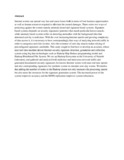Near Real Time Machine Driven Signature Detection, Generation and Collection
Abstract
Internet worms can spread very fast and cause losses both in terms of lost business opportunities
as well as human resources required to alleviate the caused damages. There exists two ways of
protecting against the worms namely anomaly based and signature based systems. Signature
based systems depends on security signatures (patterns) that match particular known attacks
while anomaly based systems relies on detecting anomalies with the background idea that
abnormal activity is malicious. With the ever increasing internet speeds and growing complexity
of data across it, it is necessary to have correspondingly fast ways of analyzing network traffic in
order to categorize activities in time. Also the existence of zero-day attacks makes relying of
preconfigured signatures unreliable. This study sought to find how to develop an accurate, robust
near real time machine driven Internet security signature detection, generation and collection
system using big data technologies such as Hadoop Map Reduce programming model and
Hadoop Distributed File System. We set up Hadoop Ecosystem at the University of Nairobi
Laboratory and gathered and analyzed both malicious and innocuous network traffic and
generated documented security signatures for known Internet worms with near real time speeds
and also corresponding signatures for synthetic worms to simulate zero-day worms. We realize
that adding the number of nodes to the Hadoop cluster not only increases the processing speeds
but also eases the resources for the signature generation system. The increased power of the
system improves accuracy and the HDFS replication improves system robustness.
Publisher
University of Nairobi

